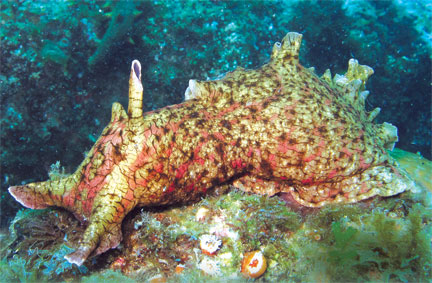A member of the phylum Mollusca and class Gastropoda, the California brown sea hare is a cousin of both nudibranchs and octopuses. Like nudibranchs, brown sea hares are hermaphrodites. Like octopuses, they can produce ink. And, though some think they bear faint resemblance to a rabbit, they are actually very large sea slugs.
Brown sea hares have a reticulated color pattern that resembles that of the two-spot octopus, also found in SoCal waters. These animals aren’t always brown, sometimes they are tan, greenish-brown or red. Their coloration depends upon what they eat, which can include red or green algae or sea grasses. Those living at the Aquarium of the Pacific eat kelp, nori and the algae that grow in their habitat. In some labs they are raised on romaine lettuce.
The brown sea hare’s resemblance to a rabbit comes from its shape and the two tentacles (rhinophores) on its head, which look a bit like rabbit ears. There is a tiny eye on each side of the head, an inch or so below the base of the rhinophore. According to A Living Bay, when moving forward the sea hare “slowly waves its head from side to side, receiving sensory input through its oral tentacles, its rhinophores and its eyes; in addition, the whole body is sensitive to touch.”
The sea hare’s mantle has wing-like flaps called parapodia on each side. These cover the gills and overlap at or near the center of the back. While brown sea hares have a shell, it is an internal one. The penis is on the right side of the head while the vagina opens in the mantle cavity, beneath the shell and between the parapodia.
California brown sea hares can grow to be 16 inches long and weigh five pounds. The measured length of any sea hare depends upon whether or not the body is extended, a fact that is, unfortunately, rarely noted. While 16-inch brown sea hares are uncommon, most of them are considerably larger than any other gastropod found in SoCal waters. They are second in size only to the black sea hare, the largest gastropod in the world. Black sea hares can be nearly twice as big as brown sea hares, reaching lengths of 38 inches and weighing a whopping 30 pounds.
It is an unusual behavior that draws many divers’ attention to brown sea hares: During certain times of year (summer and autumn) they form large aggregations called mating chains or circles, which divers are prone to call orgies. The aggregations can last a few hours or even days, with animals joining and then leaving them after mating and laying eggs. Except for the animal at the beginning and end of the chain, each sea hare is, according to the Cabrillo Marine Aquarium, “…male to the one in front and female to the one behind, so each sea hare is both a mother and a father.” After mating, each sea hare lays a string of up to 80 million pale yellow or orange eggs (that astounding number is not a typo!). The gelatinous eggs are amassed in a central pile attached to the substrate or seaweed, where they release a peptide pheromone that attracts even more sea hares. It should be noted that a pair of sea hares can mate, too.
Sea hares need to lay lots of eggs because so many are eaten by predators. Eggs that escape this fate turn a darker color in a little more than a week and hatch in 10 to 12 days. Brown sea hares only live about a year and usually die after laying eggs. (Female octopuses die after their eggs hatch.)
The larvae that emerge from the egg strings free swim for about 30 days before settling down in water about 60 feet deep. They eat so much during the next three months that their weight doubles every 10 days. All the while they are morphing into adults and growing larger as well as slowly moving into shallower water.
Unlike their carnivorous nudibranch cousins, brown sea hares are herbivores. Dining on red algae (Plocamium cartilagineum) allows them to produce purple ink as well as accumulate chemicals in their skin and internal organs that make them unpalatable to most would-be predators. Among the California brown sea hare’s few predators is the giant green anemone. It is picky about what parts of the sea hare it eats, avoiding the digestive gland, which contains the chemicals, and regurgitating everything if any toxin is accidentally eaten. It will also expel a sea hare that produces purple ink. Other predators include starfish, lobsters and a much smaller close cousin Navanax inermis. All of the aforementioned creatures only eat small sea hares; large sea hares seem to enjoy a predator-free, albeit short, existence.
Unlike many of the sea creatures featured in this column, there is a lot of information on California brown sea hares. They are, according to Wikipedia, “…important laboratory animals, valuable in neurobiology. They have very large neurons, the largest in the animal kingdom, and very few of them, making it possible to identify individual nerve cells that are responsible for specific behaviors. They have been and are being used extensively in studying memory, behavior, and learning.”
The California brown sea hares used for research are born and bred in captivity to eliminate the variables created when wild-caught animals are used. These large sea slugs are found from Oregon to Baja California, including the Sea of Cortez.
The author wishes to thank Genny and Shane Anderson for their help in the preparation of this article.
California Brown Sea Hare
Stats
Phylum: Mollusca
Class: Gastropoda
Subclass: Heterobranchia
Infraclass: Opisthobranchia
Order: Anaspidea
Superfamily: Aplysioidea
Family: Aplysiidae
Genus/Species: Aplysia californica









